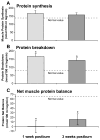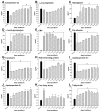Pathophysiologic response to severe burn injury
- PMID: 18791359
- PMCID: PMC3905467
- DOI: 10.1097/SLA.0b013e3181856241
Pathophysiologic response to severe burn injury
Abstract
Objective: To improve clinical outcome and to determine new treatment options, we studied the pathophysiologic response postburn in a large prospective, single center, clinical trial.
Summary background data: A severe burn injury leads to marked hypermetabolism and catabolism, which are associated with morbidity and mortality. The underlying pathophysiology and the correlations between humoral changes and organ function have not been well delineated.
Methods: Two hundred forty-two severely burned pediatric patients [>30% total body surface area (TBSA)], who received no anabolic drugs, were enrolled in this study. Demographics, clinical data, serum hormones, serum cytokine expression profile, organ function, hypermetabolism, muscle protein synthesis, incidence of wound infection sepsis, and body composition were obtained throughout acute hospital course.
Results: Average age was 8 +/- 0.2 years, and average burn size was 56 +/- 1% TBSA with 43 +/- 1% third-degree TBSA. All patients were markedly hypermetabolic throughout acute hospital stay and had significant muscle protein loss as demonstrated by a negative muscle protein net balance (-0.05% +/- 0.007 nmol/100 mL leg/min) and loss of lean body mass (LBM) (-4.1% +/- 1.9%); P < 0.05. Patients lost 3% +/- 1% of their bone mineral content (BMC) and 2 +/- 1% of their bone mineral density (BMD). Serum proteome analysis demonstrated profound alterations immediately postburn, which remained abnormal throughout acute hospital stay; P < 0.05. Cardiac function was compromised immediately after burn and remained abnormal up to discharge; P < 0.05. Insulin resistance appeared during the first week postburn and persisted until discharge. Patients were hyperinflammatory with marked changes in IL-8, MCP-1, and IL-6, which were associated with 2.5 +/- 0.2 infections and 17% sepsis.
Conclusions: In this large prospective clinical trial, we delineated the complexity of the postburn pathophysiologic response and conclude that the postburn response is profound, occurring in a timely manner, with derangements that are greater and more protracted than previously thought.
Trial registration: ClinicalTrials.gov NCT00673309.
Figures









References
-
- Przkora R, Barrow RE, Jeschke MG, et al. Body composition changes with time in pediatric burn patients. J Trauma. 2006;60:968–971. - PubMed
-
- Finnerty CC, Herndon DN, Przkora R, et al. Cytokine expression profile over time in severely burned pediatric patients. Shock. 2006;26:13–19. - PubMed
-
- Herndon DN, Tompkins RG. Support of the metabolic response to burn injury. Lancet. 2004;363:1895–1902. - PubMed
-
- Wilmore DW. Hormonal responses and their effect on metabolism. Surg Clin North Am. 1976;56:999–1018. - PubMed
Publication types
MeSH terms
Associated data
Grants and funding
LinkOut - more resources
Full Text Sources
Medical
Miscellaneous

